The Groove Issue 102 - Find The Creative Excitement in Your Life
FIND THE CREATIVE EXCITEMENT IN YOUR LIFE
For many of you, the end of August always brings ideas and feelings for new goals and projects you want to accomplish in the fall. La rentrée, as the French call the start of a new school year, is a time filled with expectations and a lot of excitement about what lies ahead.
This prompted me to investigate the role that excitement and intense positive emotions play on creativity and the materialization of great ideas.
Researchers have found that people who reported experiencing extreme or intense emotions on a regular basis scored higher on measures of creative capacity than those who simply reported feeling positive or negative emotions. That’s what Tom Wesselmann did when he found himself and his style after a period of confusion and demotivation at the beginning of his career.
You Gotta Live Out Loud
Tom Wesselmann in his studio in New York, 1964.
The great 19th Century French writer Emile Zola once said: “you ask me what I came into this life to do, I will tell you: I came to live out loud”. That’s about living life with passion and intensity, including the full depth of human experience. This is the state most conducive to creativity.
Wesselmann, considered one of the founders of Pop Art and undeniably one of the most successful artists of the era that spanned from the early 60s to the late 80s, wasn’t a particularly artistic child or what anybody would consider a genius. He started his career as most of us do: with almost nothing.
When he moved to New York from Cincinnati and attended Cooper Union School, he didn’t know exactly what to do with himself. Maybe a cartoonist? Maybe a writer? But eventually he decided to be a painter.
Years of weird moments, a divorce from his first wife, a teaching job that he despised, all of that ensued after graduation. It wasn’t a very fecund phase for creativity, and he was far from developing his style of distinctive, color-drenched pop works.
Still Life #30 was created by Wesselmann in 1963 and is now in the permanent collection of MoMA in New York.
But Wesselmann wasn’t going to let things get all sour for him and he pulled himself together: he got a therapist, and fell in love despite all his fears after his first failed relationship. He married Claire Seeley, his muse, the woman who became the mother of his three kids and who stayed with him until his passing in 2004.
He started experimenting with collages and playing with scales in his still lifes using images of everyday American objects, which then migrated to much larger paintings and later sculptures. He said: “I was excited. I was terribly excited by my work, by what was going on. I was so excited that at times it got the best of me.”
And the art world became excited with him too, as he began having sold-out solo shows and raving fans and supporters who saw the uniqueness and individuality in his work. Excitement had taken him and his work to a new level.
Find The Deep Pleasure in Your Work
Tom Wesselmann, Smoker #3 (Mouth #17), 1968, oil on canvas.
As humans, we have gone through so much collectively and individually, that I think most are clear about not staying in a job that you don’t like or pursuing a career you aren’t passionate about. That’s why we should always aim for a state of flow. When work doesn’t feel like a drag.
For Wesselmann, once he caught that wave of excitement, he never let it go. In the mid-1960s his famous nudes started to take shape, and isolated giant body parts followed: lips, breasts, feet.
“That was really when my work began to me, when I made that realization of what I'm excited by,” he said.
Get “Affectively Engaged”
Cognitive scientist Scott Barry Kaufman found in his own research that “affective engagement”— the extent to which people are open to the full breadth and depth of their emotions— was a better predictor of artistic creativity than IQ or intellectual engagement.
This behavior isn’t only a predictor of a successful career in the arts but of anyone who is excited and willing to experience the high emotions of fulfillment and joy in their jobs.
That state of intense excitement about just being alive was an enormous contributing factor to Wesselman’s creative and financial success, as he remarked: “The life I've led has been one of such keen excitement and pleasure, such deep pleasure and great satisfaction that I really can't believe the good luck.”
I’d argue that there’s no such thing as good luck, but rather, we create our own with our thoughts, behaviors, and actions.
And what better state than being excited about your life and projects to fuel your creative mind, realize your goals and become receptive to the success that comes with it?
Let’s welcome September with that feeling and sustain it throughout the fall.
UNLEASH YOUR CREATIVE GENIUS
I’ve put together a free webinar for those of you who are not members of my online course, Jumpstart.
If you’d like to watch it, please register here (it’s on auto-repeat every 15 minutes once you have registered).
HOW CREATIVITY RULES THE WORLD
I am super thrilled that my book won the International Book Award in the Business/Entrepreneurship category!
Have you already gotten your copy?
It’s in three formats: hardcover, eBook and audiobook. Get it here.
TEDX TALK
Have you already watched my TEDx Talk: “NFTs, Graffiti and Sedition: How Artists Invent The Future”?
I share three lessons I have learned from artists that always work for anyone in their careers. Watch it here.



